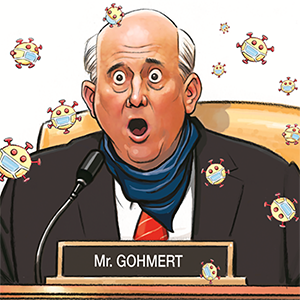Protecting yourself from the painful shingles virus may also protect cardiovascular health
Published in Senior Living Features
Shingles is a funny-sounding name for a seriously painful disease. How painful? That's hard to put into words. Printable ones, at least.
Officially, shingles pain can range from mild to severe. The words "itchy" and "burning" frequently come up in descriptions. Some use "horrendous" and "excruciating."
Sufferers might relate to David Letterman. After he missed more than a month of his late-night talk show in 2003 because of the disease, his list of "Top 10 Good Things About Having Shingles" relied on a string of expletives to make this point: There's nothing good about shingles.
Medical experts would agree. In addition to that signature rash and pain that can last for weeks, months and sometimes years, shingles – formally known as herpes zoster – also is associated with an increased risk of heart disease and stroke.
Here's what you need to know about the virus and how to protect yourself.
What is shingles?
Shingles is caused by varicella zoster, the same virus that causes chickenpox, said Dr. Sharon Curhan, a physician and epidemiologist at Brigham and Women's Hospital and Harvard Medical School in Boston.
"After a person has chickenpox, the virus stays in their body for the rest of their life," she said. Most of the time, our immune system keeps the virus at bay, but years and even decades later, the virus may reactivate as shingles.
Who's at risk?
About 1 in 3 people in the U.S. will have shingles in their lifetime, according to the Centers for Disease Control and Prevention.
Shingles affects only people who have been previously exposed to varicella zoster. In most cases, that would mean having chickenpox, but some people who are vaccinated against chickenpox can still get shingles years later, Curhan said. "Shingles is much less common after vaccination than after chickenpox disease, but it can occur."
Almost everyone in the U.S. born in or before 1980 has had chickenpox, the CDC says. A chickenpox vaccine has been widely available in the U.S. since 1995.
Shingles most commonly breaks out in people older than 50, Curhan said. People over the age of 60 are more likely to experience severe complications.
You can't catch shingles from someone with the disease. But if you've never had chickenpox or been vaccinated for it, you could catch the varicella zoster virus from them. That would start as chickenpox, which could later lead to shingles.
In most cases, it's not clear what triggers shingles, Curhan said. But some research has linked stress to shingles development. Other research suggests physical trauma is also a risk factor, particularly for shingles that involves the face and head. Even a history of severe or blistering sunburns may slightly increase the risk, according to a 2019 study co-written by Curhan.
She said conditions that weaken the immune system can increase the risk of shingles, as can some drugs, including steroids, that are used to treat autoimmune diseases.
According to the CDC, most people who develop shingles will have it only one time during their life. However, it's possible to have it more than once.
What are the symptoms?
Shingles most commonly presents as a painful rash that many people describe as a deep burning, throbbing or stabbing sensation, Curhan said.
The virus usually inflames one or two adjacent clusters of nerves. "People typically feel the pain, itching or tingling in the area where the rash will then develop," she said. "Even a 'mild' case can be extremely painful and debilitating."
The rash may look like a stripe or a region of blisters that covers an arm, leg or one side of the face or torso. (The term "shingles" comes from the Latin "cingulum," which means belt or girdle.)
It can resemble insect bites or other skin conditions, Curhan said. Sometimes, it can be mistaken for a heart, kidney or lung issue.
"If shingles involves the cranial nerves of the head, a person could experience facial paralysis, severe headache, changes in vision or hearing, or other symptoms that could be mistaken for a stroke," Curhan said. Symptoms felt before the rash appears may also be misinterpreted as angina, gallbladder disease, appendicitis or a kidney stone.
"Anyone who experiences symptoms that are of concern should promptly be evaluated by a health care provider," she said.
The rash typically scabs over and clears within two to four weeks, she said. But the pain in the area of rash can last for 30 days or more, and the duration of pain seems to increase with age.
Some people have pain without a rash. Others also develop fever, chills, headache, sensitivity to light, fatigue or upset stomach, sometimes before the rash appears.
If you develop symptoms, see a doctor quickly, the CDC says. Antiviral drugs are most effective within 72 hours of the onset of symptoms.
What are some long-term effects?
An estimated 10% to 18% of people with shingles develop postherpetic neuralgia– a "potentially debilitating" pain that persists for three months or more, Curhan said.
People also can develop eye problems and neurological complications.
What's the link between shingles and cardiovascular issues?
Curhan was lead author on a study published in the Journal of the American Heart Association in 2022 that looked at data from more than 205,000 adults and found those who had shingles had a nearly 30% increased risk of experiencing a future cardiovascular event.
The risk for having a stroke was up to 38% higher among people with a history of shingles compared to those without. For coronary heart disease, which included having a heart attack or needing a heart procedure such as a coronary artery bypass graft, the risk was up to 25% higher.
"We also found that the higher risk persisted for 12 years and possibly longer," she said.
What's behind that increased risk? "There is a growing body of evidence that links the varicella zoster virus to vascular disease," Curhan said. Varicella zoster is "the only human virus demonstrated to replicate in arteries and lead to vasculopathy," or blood vessel damage, she said.
What prevents shingles?
The CDC says vaccination is more than 90% effective at preventing shingles and postherpetic neuralgia in adults 50 years and older with healthy immune systems. The federal agency recommends that people 50 and older get two doses of the recombinant zoster vaccine, spaced two to six months apart.
That includes people who have had shingles or an older vaccine, Zostavax, which was discontinued in 2020. Younger adults also should get the vaccine if they are immunocompromised.
Vaccination might reduce the risk of cardiovascular complications from shingles as well, Curhan said. A 2021 study in the journal Stroke found that people who received the older vaccine had a lower risk of stroke than unvaccinated people.
Where is the vaccine available?
More than 80% of shingles vaccinations are done at a retail pharmacy, said Dr. Dima Qato, an associate professor at the University of Southern California Mann School of Pharmacy.
Qato recently studied how eliminating Medicare co-payments increased access to the vaccine. "However, we also know there's disparities," she said. Black and Latino people are less likely to get vaccinated for shingles than white people.
What are the possible vaccine reactions?
Evidence shows the newer shingles vaccine is safe and effective for most people, Curhan said. Exceptions would be people who are allergic to its components.
Some people have soreness, redness, swelling or pain in the arm at the site of the injection, she said. Others experience fatigue, headache, muscle aches, stomach pain or nausea that might last for two to three days.
For sure, the benefits of vaccination exceed the risks, because shingles is serious, Qato said. "It's not something to take lightly."
____
American Heart Association News covers heart and brain health. Not all views expressed in this story reflect the official position of the American Heart Association. Copyright is owned or held by the American Heart Association, Inc., and all rights are reserved.









Comments